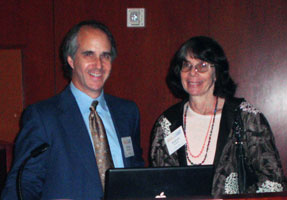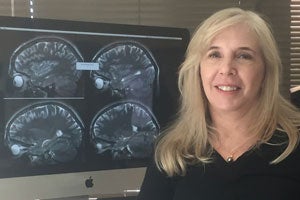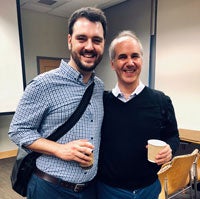Dr. Ivar Lovaas establishes behavior modification as the first effective treatment for autism, finding that children make remarkable progress when they received intensive intervention based on applied behavior analysis (ABA). ABA continues to demonstrate efficacy through rigorous clinical trials.
Dr. Edward Ritvo and Dr. Edward Ornitz describe the first EEG-based studies used to investigate the neurophysiological mechanisms underlying autism. They are the first to recognize sensory processing abnormalities in autism.

Dr. Marian Sigman creates one of the first well-articulated developmental programs of research that uncovers many of the characteristics that are now considered core deficits of ASD. These core deficit areas include social communication, joint attention, social motivation and social orienting; they remain central to CART’s research program.
Dr. BJ Freeman establishes the Early Childhood Partial Hospitalization Program (ECPHP), recently renamed KidsConnect and currently directed by Dr. Stephanny Freeman and Dr. Tanya Paparella. This unique, effective day-treatment program is for young children who have been diagnosed with, or may have, autism, developmental disabilities, and behavior disorders.
Dr. Daniel Geschwind and Cure Autism Now Foundation establish the Autism Genetic Resource Exchange (AGRE). At this time, AGRE is the largest, private, open-access repository of clinical and genetic information dedicated to autism research.
Dr. Marian Sigman and colleagues are recognized as a Collaborative Program of Excellence in Autism (CPEA) by the NIH. The CPEA network is the first of its kind to address unique research topics at each center. This 5-year program enables researchers to focus on the neurobiology and genetics of autism. Dr. Marian Sigman and colleagues examine the bases for communication and social deficits in children with autism. Read more here.

Dr. Marian Sigman and Dr. Daniel Geschwind establish the Center for Autism Research and Treatment (CART) in the Jane and Terry Semel Institute for Neuroscience and Human Behavior at UCLA bringing together experts at UCLA in genetics, brain imaging, pharmacology, and behavioral intervention.
Dr. Marian Sigman leads Studies to Advance Autism Research and Treatment (STAART) at UCLA. Funded by the NIH, STAART is a five year program enabling sites to conduct individual and collaborative projects to learn more about the causes, diagnosis, early detection, prevention, and treatment of autism.

Dr. Elizabeth Laugeson and Dr. Fred Frankel develop the Program for the Education and Enrichment of Relational Skills (PEERS®) intervention for adolescents at UCLA. This intervention provides evidence-based social skills for individuals with attention deficit/hyperactivity disorder (ADHD), anxiety, depression, and other socio-emotional problems.
Dr. Daniel Geschwind and colleagues identify the gene CNTNAP2 as a risk factor for ASD and related neurodevelopmental disorders.
CART is named an NIH Autism Center of Excellence (ACE) to support an interdisciplinary, multi-level, and fully translational research program with strong collaborations between laboratories. CART researchers seek to understand how ASD affects the ability to communicate, examining clues to language-related communication problems by looking at genes, behavior, brain structure and function. Researchers also examine the relationship between ASD and mirror neurons. The ACE Center is led by principal investigator, Dr. Marion Sigman and Dr. Daniel Geschwind.
Dr. Shafali Jeste joins CART faculty and creates the Electrophysiology Core laboratory to enhance autism research for infants and minimally verbal young children.
Dr. Elizabeth Laugeson develops the Program for the Education and Enrichment of Relational Skills (PEERS®) intervention for young adults. This intervention provides evidence-based social skills for individuals with attention deficit/hyperactivity disorder (ADHD), anxiety, depression, and other socio-emotional problems.
Dr. Connie Kasari and colleagues from autism centers around the country form the Autism Intervention Research Network (AIR-B). The goal of AIR-B is to deploy effective and sustainable evidence-based practices that will serve a broad community base and improve outcomes for all children with ASD. Researchers focus on novel interventions delivered to underserved and under-represented community settings to reduce core deficits of children with ASD.
Dr. Daniel Geschwind begins studying genetic susceptibility for autism in families of African-American descent in collaboration with Dr. John Constantino at Washington University in St. Louis. With a goal of increasing racial diversity in autism research and understanding health disparities underlying different rates of autism diagnosis in African-Americans compared to Caucasians, this was the first and remains the only study of its kind, with continuous funding since this time from NIMH.
Dr. Elizabeth Laugeson develops the Program for the Education and Enrichment of Relational Skills (PEERS®) intervention for preschoolers. This intervention provides evidence-based social skills for individuals with attention deficit/hyperactivity disorder (ADHD), anxiety, depression, and other socio-emotional problems.
Dr. Susan Bookheimer, Dr. Mirella Dapretto, and Dr. Daniel Geschwind and colleagues use functional brain imaging to examine the relationship between genetic variants in CNTNAP2, a gene recognized as contributing to ASD risk, and connectivity between different brain regions. This multi-disciplinary study finds that ASD susceptibility variants (or changes in the sequence of the gene that increase a person’s risk for having ASD) identified in CNTNAP2 through prior genetic studies correlate with changes in brain connectivity observed in individuals with ASD, thus suggest a mechanism through which CNTNAP2 variants act to cause ASD. Read more here.

Dr. Elizabeth Laugeson establishes the Program for the Education and Enrichment of Relational Skills (PEERS®) Clinic at UCLA. This clinic provides evidence-based social skills to preschoolers, adolescents, and young adults with ASD, attention deficit/hyperactivity disorder (ADHD), anxiety, depression, and other socio-emotional problems. She also publishes Social Skills for Teenagers with Developmental and Autism Spectrum Disorders: The PEERS® Treatment Manual, focused on the topic of social skills training for people with ASD and other social challenges. This book has been translated into numerous languages across the globe.
Dr. Connie Kasari’s research on her JASPER behavioral intervention is named a “2010 Top Ten Autism Research Achievement” by Autism Speaks. JASPER (Joint Attention, Symbolic Play, Engagement, and Regulation) is a treatment approach that targets the foundations of social communication (joint attention, imitation, play) and uses naturalistic strategies to increase the rate and complexity of social communication.
Led by Dr. Connie Kasari, the Autism Intervention in Research Network is renewed (AIR-B II). AIR-B II expands to include additional sites and a new partnership with Healthy African American Families (HAAF), led by Dr. Loretta Jones, founder and CEO of HAAF and assistant professor at Charles R. Drew University of Medicine and Science. HAAF works to improve the health outcomes of the African American, Latino, and Korean communities in Los Angeles County. This partnership implements Community Partnered Participatory Research (CPPR), enabling people in the community to ensure that researchers understand community needs and concerns.
Dr. Daniel Geschwind’s lab shows that autism has a molecular pathology and defines its components in a groundbreaking study published in Nature.
Led by a collaboration with colleagues at Stanford University, the Geschwind Lab characterizes the first model of autism in a dish using human induced pluripotent stem cells.
CART is again named an NIH Autism Center of Excellence (ACE) and is the only previously funded center to receive the grant a second time. The ACE Center grant enables CART’s research to integrates genetic and biological markers of autism with behavioral approaches. Researchers utilize brain imaging technology to chart brain development among individuals having genes suspected of contributing to ASD and examine the link between genetic variants to distinct patters of brain development, structure and function in ASD. Researchers also focus on investigating treatments to improve social behavior and attention in infants and acquisitions of language in older children with ASD. The second ACE Center is led by principal investigator, Dr. Susan Bookheimer and co-PI Dr. Daniel Geschwind.
<p>CART researchers receive two Autism Center of Excellence (ACE) Network grants from the NIH. </p> Dr. Connie Kasari, lead principal investigator, along with collaborators from sites around the country, compare two types of intensive, daily instruction for children with ASD who use only minimal verbal communication. Dr. Susan Bookheimer and Dr. Mirella Dapretto, along with collaborators from sites around the country, investigate the poorly understood nature of ASD in females, with plans to recruit the largest group of girls with ASD studied to date.
Dr. Daniel Geschwind and colleagues identify the gene CNTNAP2 as a risk factor for ASD and related neurodevelopmental disorders.
Dr. Daniel Geschwind and colleagues identify the gene CNTNAP2 as a risk factor for ASD and related neurodevelopmental disorders.
UCLA has been at the forefront of innovative research in autism spectrum disorder (ASD) for over 50 years, with the research and treatment conducted at UCLA setting the standard for many of the models currently used today.
In 2003, the Center for Autism Research and Treatment (CART) was founded in the Jane and Terry Semel Institute for Neuroscience and Human Behavior at UCLA. Led by Dr. Marian Sigman and Dr. Daniel Geschwind, the newly formed interdisciplinary center brought together experts in genetics, brain imaging, pharmacology, and behavioral intervention, and now includes faculty from the UCLA departments of Psychiatry and Biobehavioral Sciences, Neurology, Human Genetics, Pediatrics, Biostatistics, and the Graduate School of Education and Information Studies. This strong, collaborative environment for basic and clinical research allows UCLA CART scientists and clinicians to apply the most innovative scientific methods to understand the biological basis of ASD so that precise diagnoses can be made and effective, targeted treatments can be developed; to provide education and outreach to individuals with ASD and their families in order to bridge the gap between leading-edge science and the community; and to advance the scope and effectiveness of interventions through new research for individuals with ASD across the lifespan.
Since our establishment, UCLA CART has been recognized as the leading center in the United States, earning numerous funding awards from the National Institutes of Health (NIH), including substantial support from the NIH Autism Centers of Excellence (ACE) program. For three consecutive awards totaling 15 years to date, NIH has supported the research of UCLA CART investigators as a strong collaborative group able to work synergistically to study autism. Simultaneously, UCLA CART investigators have also received multiple ACE Network grants, enabling collaboration with major autism centers from other universities around the country. Check out the timeline below to learn more about the innovative and cutting-edge work at UCLA CART.



2018: CART researchers score 3 of top 10 autism studies in 2018 by Autism Speaks in an annual listing of notable autism research.
Dr. Connie Kasari and colleagues examined how a UCLA-developed approach to personalized autism intervention, known as SMART, can be used by researchers to improve how they evaluate new treatments.
Dr. Catherine Lord and colleagues provided important information about the highly variable development of autism symptoms and the severity among very young children.

